Mons (French pronunciation: [mɔ̃s]; Dutch: Bergen "mountains"; Picard: Mont) is a Belgiancity and municipality, and the capital of the province of Hainaut.
Together with the Czech city of Plzeň, Mons is the European Capital of Culture in 2015.
Contents
[hide]- 1 History
- 2 Main sights
- 3 Festivities
- 4 Education
- 5 Transportation
- 6 Sports
- 7 Planning and architectural heritage
- 7.1 The main square
- 7.2 City Hall
- 7.3 The Sainte-Waudru Collegiate Church
- 7.4 The Belfry
- 7.5 Press house (Spanish house)
- 7.6 The water machine
- 7.7 Waux Hall
- 7.8 The Perfect Union
- 7.9 Art Square
- 7.10 Fontaine-pillory
- 7.11 The Red-Well
- 7.12 The casemates
- 7.13 Valenciennois tower
- 7.14 Concourse of the Courts
- 8 Patron saint
- 9 People born in Mons
- 10 Twin cities
- 11 See also
- 12 References
- 13 External links
Mons: it's the European Capital of Culture – but locals just want to go to Ikea
Only one of the new buildings is ready, its centrepiece artwork had to be dismantled after bits fell off – and people are more excited about getting their first Ikea. Is the Belgian city the final nail in the coffin for European Capitals of Culture?
A cloud of planks swirls above the streets in the Belgian city of Mons, thrusting neon-painted splinters out in all directions. Like the jazzy nest of some mutant raver-crows, it is a curious arrival to the sleepy medieval lanes, a 90m-long torrent of orange sticks between the classical law courts and the baroque bell tower. It can only mean one thing: the European capital of culture 2015 has arrived.
That was the scene last week. Now all that remains of the €400,000 centrepiece of the city’s cultural jamboree is a few broken stumps jutting out of the pavement. The entire sculpture, designed by Belgian artist Arne Quinze and intended to stand here for the next five years, has been dismantled after just five weeks, following concerns over its stability after chunks of wood fell to the ground.
“It’s a precautionary measure. We will not take any chances,” said the city’s usually ebullient mayor, Elio di Rupo, who recently returned to lead his hometown after three years as Belgium’s prime minister. “We have talked about reconstruction, but we must first absorb the shock.”
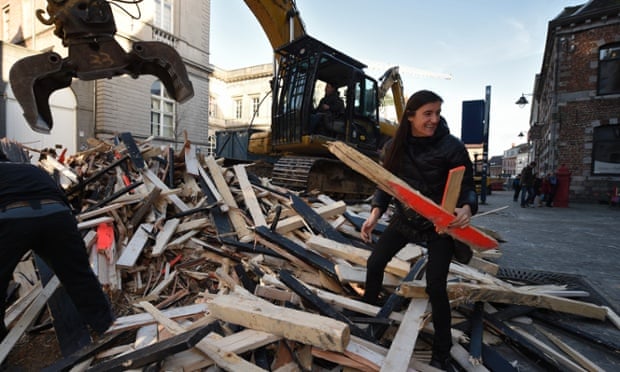
The collapse of the neon nest heralds a rocky start for a year of cultural celebration that has so far been defined by a notable absence of the promised projects. The flamboyant bow-tie wearing Di Rupo was first elected mayor of Mons in 2000, since when he set his sights on bidding for Capital of Culture status to reverse the fortunes of the depressed former mining town. Having lured the likes of Google, Microsoft and IBM to form something of a Silicon Hill on the edge of Mons, he initiated a lavish series of grands projets to revitalise the city centre for 2015 – most of which have yet to materialise.
A €155m new station, designed by Santiago Calatrava as a swooping sci-fi bird, is so far no more than a concrete foundation slab. It replaces a much-loved 1950s station by a local architect, and it’s now optimistically scheduled to open in 2018, having escalated to four times its original budget. There will eventually be five new museums too, from a war memorial centre to an art library in a restored convent, but all are still very much building sites and won’t open until April at the earliest.
“They call Mons ‘The First and the Last’,” says the Capital of Culture’s curator, Yves Vassuer, “because it’s the place where the first and last British soldiers were killed in the first world war.” It could also be the subtitle for its cultural year: the first city to bid and the last one to be ready.
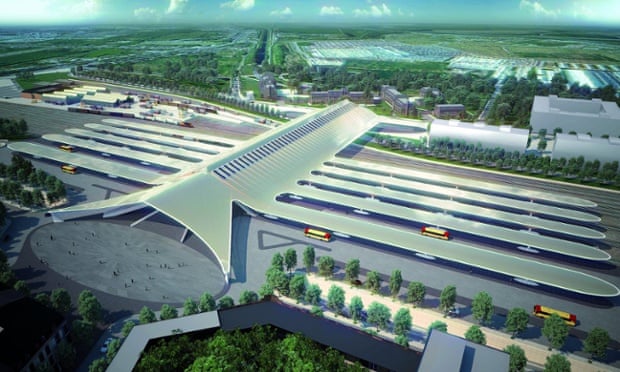
One of the showcase projects has thankfully finished on time and on budget – although, from a distance, it looks like it might have suffered the same fate as the doomed nest. Lying like the twisted hull of a shipwrecked boat, marooned across the railway tracks from the old town centre, stands Daniel Libeskind’s new €30m conference centre, the afternoon sun bouncing off its fractured hull.
“How cool!” says a beaming Libeskind, standing in snakeskin cowboy boots on top of the building, hot off a plane from New York, as he admires the golden glow of a shard poking through the roof. “What else is architecture if not a ray of light on a wall?”
Below him, a tilted facade of wooden slats sweeps out in a broad arc, forming a streamlined front to the building, before colliding with another curving wall clad with gold-anodised aluminium. It is Libeskind’s trademark brand of acute angles and collisions, with windows liberally slashed into the skin; but, as his projects go, the architectural acrobatics here are relatively restrained.
As usual, he says the dynamic geometries are generated by the context: the building acts as “a vortex that connects the outside elements,” drawing connections with the future station and pointing its sharp prow in line with the belfry, as “a hinge between the old city and the new”. The new city has yet to materialise – there will one day be a hotel, financial centre and apartments nearby – so the success of his strategy is hard to judge. For now, the energetic performance of leaps and twists plays to a silent audience of concrete foundations, echoing across an empty street, whose name, Chemin de l’Inquiétude, translates fittingly as Anxiety Way.
“I have a track record with inauspicious street names,” laughs Libeskind. His €80m Grand Canal theatre in Dublin bay, the trophy of an ill-fated billionaire property speculator, fronts on to Misery Hill. It was recently sold for €28m, four years after it opened, its developer racked by debt.
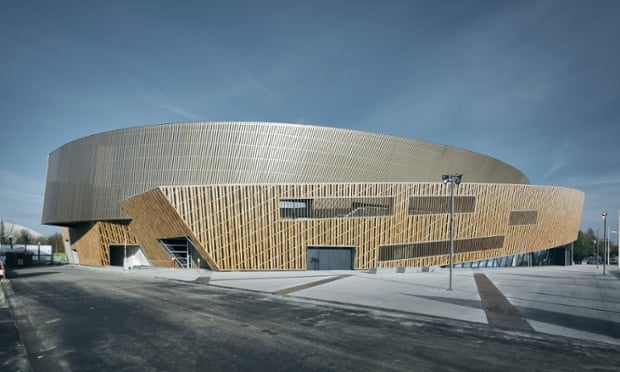
Stepping inside the conference centre, the gold and timber shell envelops a bright white world, sliced with slanting staircases and wayward walls. The three conference auditoriums are linked by an airy space criss-crossed with lighting tracks recessed into the ceiling, described in Libeskind-speak as “a matrix of dynamic lines that give proportionality to the movement of people”.
Sensing I might not buy his quasi-spiritual ley-line rhetoric, he is frank: “I just wanted to make it a fun place to be in,” he says. “When you’re stuck in these monotonous conference events all day, the important thing is to make it very lively.” Bright and lively it is, but you can’t escape that feeling of being trapped in a re-run, listening to a Libeskind deconstructivist symphony on loop.
When the seminal Jewish Museum opened in Berlin in 2001, Libeskind’s unique language of jarring fissures was a shock to the system. Here was a gigantic metal shed, wrenched open by the trauma of the Holocaust. It was architectural space wrought with the power of an earthquake. Almost 15 years on – with a plethora of wonky shopping malls and faceted apartments under his belt – Studio Daniel Libeskind has flattened the aesthetic of trauma into a form of appliqued styling. No matter whether you want a memorial or a conference centre, you order the same angular outfit of Holocaust lite.
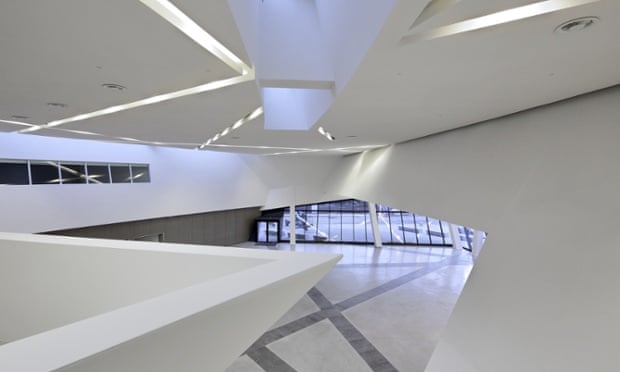
Flanked by the white wings of the mail-order Calatrava station, is this really what the plucky Mons needs? The forthcoming museums – mostly conversions of historic buildings by local Wallonian architects – look promising, so why not pick one of Belgium’s rising stars (of which there are many) for the job?
The answer can be found in the Mons marketing material, which breathlessly describes how the city’s new “nerve centre” will boast “two major projects by internationally renowned architects, who are currently working on Ground Zero in New York!” Never mind that Ground Zero is one of the most compromised developments of the decade, or that Calatrava’s alleged track record of spiralling budgets inspired a website called “Calatrava bleeds you dry”.
The whole European Capital of Culture endeavour breeds a relentlessly shallow logic, that a dose of metropolitan sparkle can be bought by importing a clutch of celebrity architects and their signature shapes. Like children drawing up a Christmas wish-list, it encourages mayors to dream big and lust after buildings they don’t need and can’t afford, too often leaving a slew of oversized, underused cultural monuments in its wake.
Leaving Mons by train, I ask the city’s press officer what the new station will eventually be like. “Oh it’s just the same as the Calatrava station in Liège,” she says, referring to the €300m rail hub that opened five years ago. “Most people in Mons are much more excited about the imminent arrival of Ikea – it will be the first ever branch in Wallonia.”

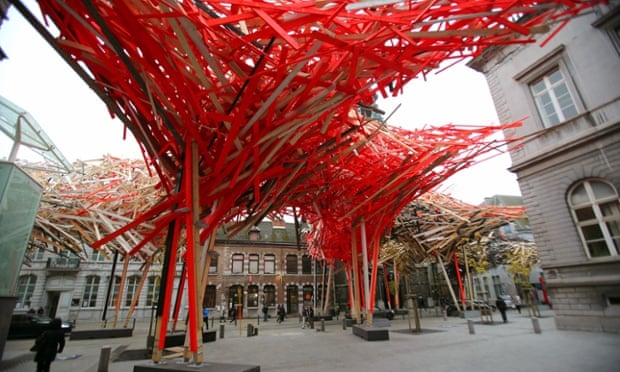

沒有留言:
張貼留言